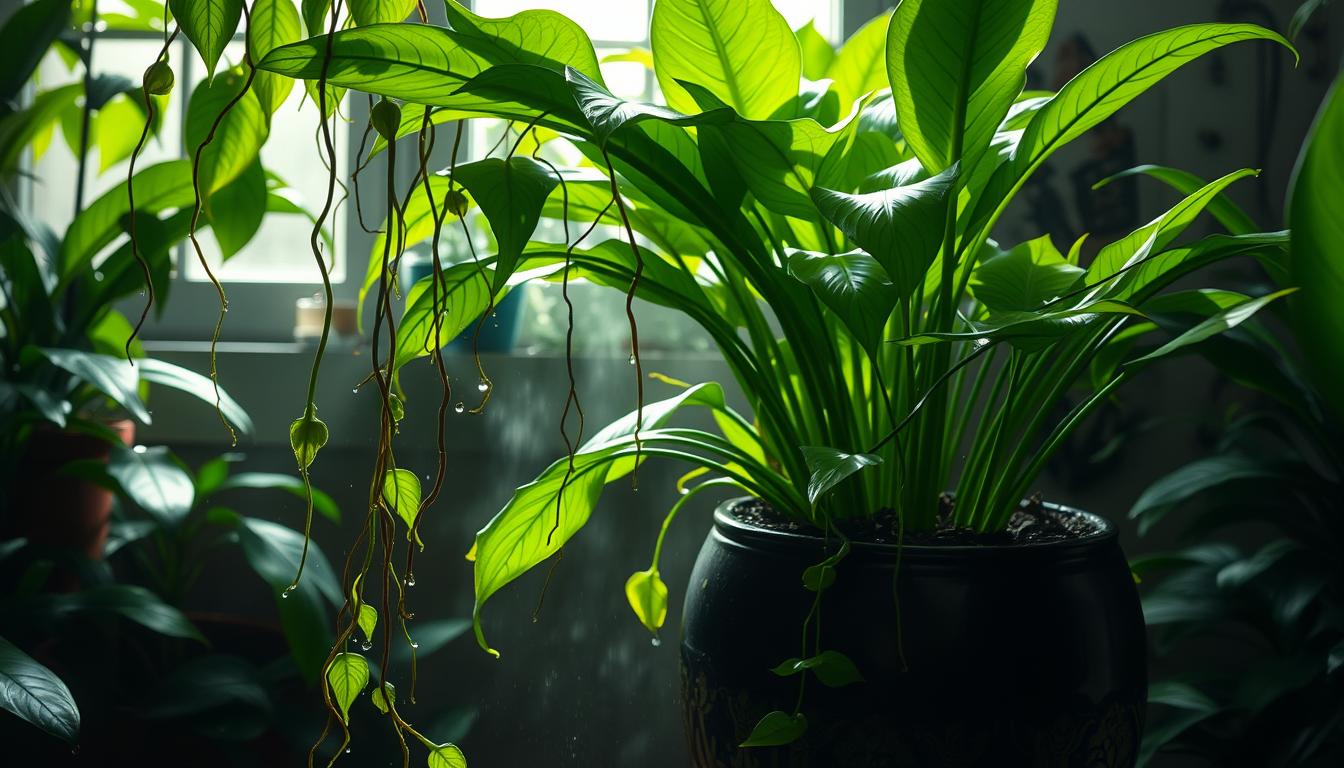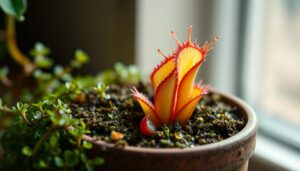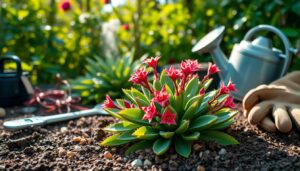Thinking about getting a new plant? The Arrowhead plant is a great choice. It has cool leaves and can live in low light. With the right care, this fast-growing vine will do well in many places.
The Arrowhead plant, or Syngonium Podophyllum, is easy to grow. It can grow up to 1.2 m tall. Knowing its size helps you care for it better.
Arrowhead plants like it warm, between 18°C to 26°C. They also need the right amount of water. Let the soil dry out before watering again. This makes it easy to care for.
Learning about Arrowhead plant care makes you a great plant parent. We’ll talk about how to care for it, including what it needs to grow. This info is good for both new and experienced plant owners.
Understanding the Arrowhead Plant’s Characteristics
The Arrowhead plant is a favorite for indoor gardens. It comes from the tropical areas of Central and South America. This natural habitat makes it love bright, indirect light and well-draining soil.
Its unique leaf shape is a standout feature. Leaves can grow up to 6 inches long and are shaped like an arrow. As it grows, the leaves change shape, adding interest to any room. You can pick from many varieties, like ‘Bold Allusion’ and ‘Pink Splash’, to match your style.
The Arrowhead plant loves medium to bright indirect light. It also needs high humidity and well-draining soil. Knowing these needs helps your plant thrive. It’s perfect for anyone wanting to bring greenery into their home.
Some popular varieties include:
- ‘White Butterfly’ with its creamy white leaves and dark green edges
- ‘Neon Robusta’ with its vibrant pink leaves
- ‘Berry Allusion’ with its soft pink and green hues
These options range from subtle to bold, giving you choices for your space.
Ideal Growing Conditions for Arrowhead Plants
To make your Arrowhead plant happy, think about light, water, and food. It likes bright, indirect light. You can put it near a sunny window or use grow lights.
The soil matters too. Use a mix that drains well, like one with perlite or orchid bark. This keeps the soil from getting too wet and stops root rot.
Optimal Lighting Requirements
Arrowhead plants can handle low light but prefer medium to bright. For the best growth and color, give them lots of indirect sunlight.
Preferred Soil Type
Arrowhead plants need a soil that drains well. This stops water from staying in the soil and prevents root rot. Look for a mix with perlite or orchid bark for good drainage.
Ideal Temperature and Humidity Levels
They like temperatures between 65-85°F and humidity of 40-60%. Use a pebble tray or mist them often. This keeps the air humid and helps your plant grow well.
Watering Techniques for Arrowhead Plants
Arrowhead plants need consistent watering. The soil should be moist but not too wet. This prevents the plant from getting too much water.
Water your plant well. Let the top inch of soil dry before watering again. This keeps the plant healthy.
Check the soil by feeling it. Water when it’s dry to the touch. Remember, Arrowhead plants like more humidity.
Frequency and Amount of Watering
How often and how much water you give depends on your plant’s size and your home’s humidity. For a 5″ pot, water with 0.5 cups every 9 days. This is especially true if it’s not in direct sunlight.
Signs of Overwatering vs. Underwatering
Knowing the signs of too much or too little water is key. Overwatering makes leaves turn yellow and the stem soft. Underwatering causes leaves to wilt and the stem to become dry and brittle.
By following these tips, you can learn to water your Arrowhead plant just right. This will help it grow strong and healthy.
| Watering Frequency | Amount of Water | Humidity Levels |
|---|---|---|
| Every 9 days | 0.5 cups | Higher humidity |
Fertilizing Your Arrowhead Plant
To keep your Arrowhead plant happy, fertilizing is key. Use a balanced, water-soluble fertilizer. It should have nitrogen, phosphorus, and potassium. The best ratios are 10-10-10 or 20-20-20.
For more tips on feeding indoor plants, check out trusted houseplant guide.
When you fertilize your Arrowhead plant, use half the amount. This stops the roots from getting burned. Feed your plant once a month in spring and summer.
In the quiet season, fertilize less or not at all. This stops overfeeding. A good rule is to use half the liquid fertilizer you think you need.
Some important things to remember when fertilizing your Arrowhead plant are:
- Use a balanced fertilizer with a 10-10-10 or 20-20-20 ratio.
- Apply the fertilizer at half the recommended strength.
- Fertilize once a month when it’s growing.
- Lessen fertilizing in the quiet season.
By following these tips and using the rightArrowhead plant nutrients, your plant will stay healthy. Watch how your plant reacts to the fertilizer. Change your schedule if needed to avoid too much or too little.
Propagating Your Arrowhead Plant
Exploring Arrowhead plant care shows you can share or grow more plants. You can use stem cuttings or division for propagation. For stem cuttings, take 4-6 inch pieces from the top of the plant. Root them in water or a mix that drains well.
For best results, cut just above a node at the stem tip. Place them in a warm, humid spot. Keep the soil wet. Root hormone can help too. Roots will show in 6-7 days, and more in 2 weeks with water.
Methods of Propagation
- Stem cuttings: Take 4-6 inch stem cuttings from the mother plant and root them in water or a well-draining potting mix.
- Division: Divide a mature Arrowhead plant when it has outgrown its pot, using natural divisions in the root ball as indicators for cutting.
Tips for Successful Propagation
For successful propagation, keep the area warm and humid. Use clean water for water propagation. Change the water every 5-7 days to stop bacteria. Follow these tips and methods to grow more Arrowhead plants.
| Propagation Method | Rooting Time | Water Change Frequency |
|---|---|---|
| Water Propagation | 6-7 days | Every 5-7 days |
| Soil Propagation | 4-6 weeks | Every 4-5 days |
Pests and Diseases to Watch For
When you take care of your Arrowhead plant, watch out for pests and diseases. Pests like mealybugs and spider mites can harm your plant. Check your plant often for signs of pests.
Diseases like root rot, powdery mildew, and fungal leaf spots can also affect your plant. Root rot happens when you water too much. To avoid this, let the soil dry out between waterings. For powdery mildew and fungal spots, remove sick leaves and make sure air moves well around your plant.
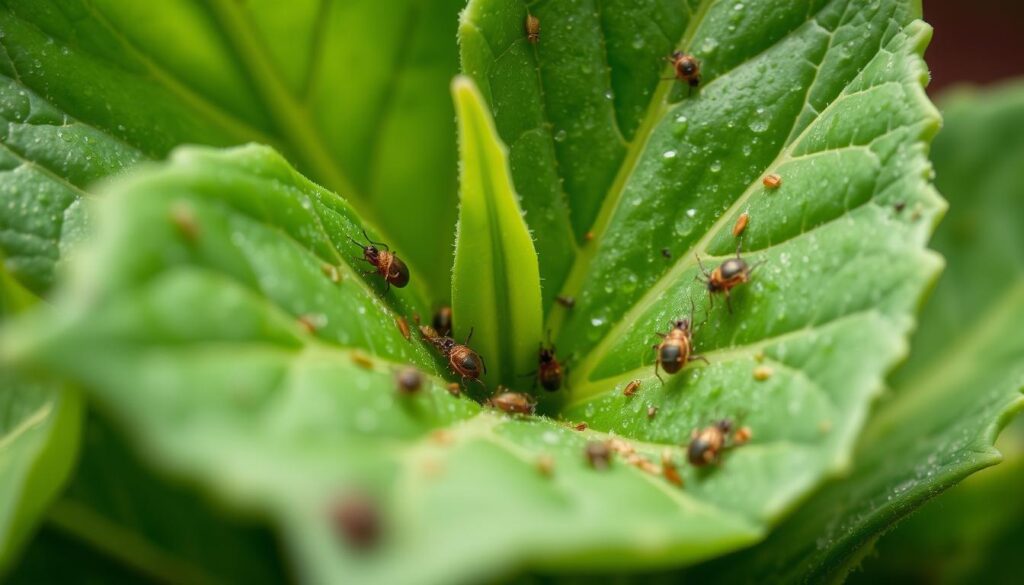
- Look for mealybugs, spider mites, and scale. Use insecticidal soap or neem oil to treat them.
- Check for root rot by looking for black or brown mushy stems near the soil.
- Remove sick leaves to stop diseases from spreading.
- Make sure air moves well around your plant to prevent powdery mildew and fungal spots.
By being proactive, you can keep your Arrowhead plant healthy. Watch your plant closely and act fast if you see any problems. With the right care, your Arrowhead plant will grow strong and add beauty to your home.
Pruning Your Arrowhead Plant
Pruning is key to caring for your Arrowhead plant. It keeps the plant looking good and growing well. Knowing when and how to prune is important.
The best time to prune is in spring and summer. This is when the plant grows most. Prune 2 to 3 times a year for a bushy look.
Techniques for Effective Pruning
Use sharp scissors or pruning shears to prune. Cut just above a node. Remove any sick or brown leaves. This stops disease and helps growth. For more tips, check trusted houseplant guides on Arrowhead plant maintenance.
Some important things to remember when pruning include:
- Prune during the growing season for best results
- Use clean, sharp scissors or pruning shears
- Make cuts just above a node
- Remove discolored or diseased leaves
By following these tips, your Arrowhead plant will thrive. Prune often to keep it bushy and healthy.
Maintaining Humidity Levels
To make your Arrowhead plant happy, you need to keep the humidity right. It likes it when the air is between 40-60% humid. This helps it get the moisture it needs from the air.
If the air gets too dry, the plant might get stressed. It could start to droop or get brown tips. But if it’s too wet, it might get sick. To keep it just right, you can use a humidifier or a tray with water and pebbles. This makes the air around the plant feel like its home.
Importance of Humidity for Growth
Humidity is key for your Arrowhead plant to grow well. In the wild, it lives in very humid places. By making your home humid like that, your plant will grow strong and healthy.
Options to Increase Humidity
There are many ways to make the air around your plant more humid. Here are a few:
- Using a humidifier to keep the air steady
- Putting the plant on a tray with water and pebbles
- Grouping plants together to make a humid spot
- Misting the plant often to keep it moist
Keeping the right humidity helps your Arrowhead plant grow well. Make sure to check the humidity often. Adjust it as needed to give your plant the best home.
Re-Potting Your Arrowhead Plant
As your Arrowhead plant grows, it will need a bigger home. This is called Arrowhead plant re-potting. It gives the plant fresh soil and room for its roots. The best time to do this is in the spring and summer.
To know if your plant needs a new home, watch for roots coming out. Or if the plant feels too heavy. Use a mix of soil, perlite, and orchid bark for the new pot. This mix helps prevent soggy soil and lets the roots grow.
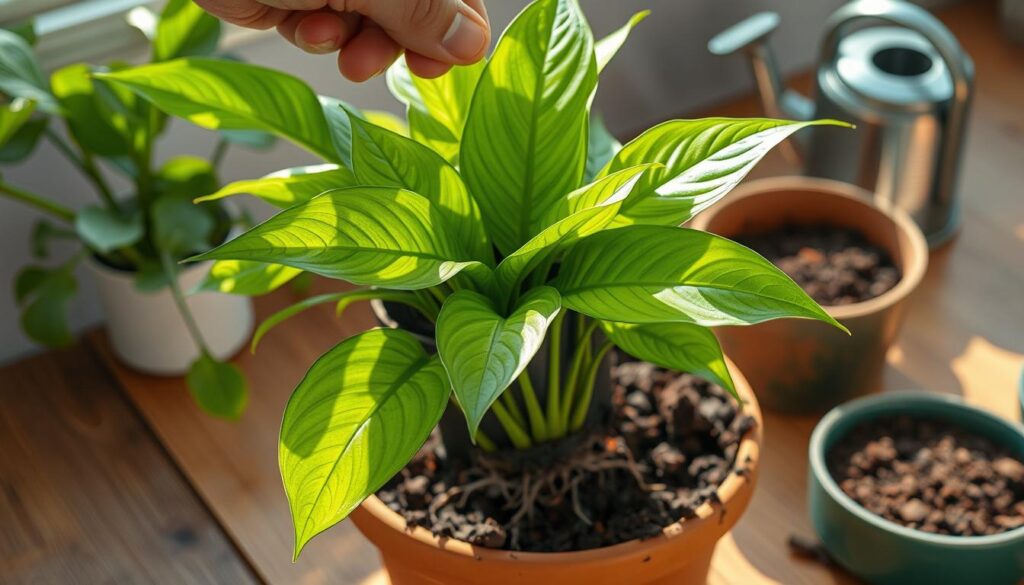
- Choose a pot that’s only 1-2 sizes bigger than the old one. This keeps the soil from getting too wet.
- Use a good Arrowhead plant potting mix made for houseplants.
- Water your plant well after re-potting. This helps the soil settle and keeps it moist.
By following these tips and using the right mix, your plant will do great. You’ll enjoy its beautiful leaves for many years.
Troubleshooting Common Issues
When you take care of your Arrowhead plant, you might see some common problems. Arrowhead plant troubleshooting helps you fix these issues early. Yellow leaves can mean too much or too little water, or not enough food. Check the soil and water it right.
Stunted growth is another issue. It might mean your plant doesn’t get enough light, water, or food. Make sure it gets enough of all three. You might also need to repot it for fresh soil and a bigger home. For more help, check out online resources.
Some common problems with Arrowhead plants include:
- Root rot from too much water
- Leaf spot disease from fungi
- Pests like spider mites and mealybugs
To avoid these issues, watch your plant closely. Act fast if you see any problems. By following these tips, you can keep your plant happy and healthy.
| Common Issue | Cause | Solution |
|---|---|---|
| Yellowing leaves | Overwatering, underwatering, or lack of nutrients | Adjust watering schedule and fertilize regularly |
| Stunted growth | Lack of light, water, or nutrients | Provide sufficient light, water, and nutrients, and consider repotting |
Seasonal Care for Your Arrowhead Plant
As you care for your Arrowhead plant, remember the seasons change. Each season brings different needs for your plant. In winter, your plant needs less water because the air is dry. This is key for Arrowhead plant winter care.
Here are some tips to adjust your care:
- Water less often in winter to avoid root rot
- Keep the temperature between 65-75°F
- Give it bright, indirect sunlight for growth
Adjustments During Winter
In winter, watch how wet your plant is. Too much water can harm it. Learn more about Arrowhead plant winter care to keep it healthy all year.
Summer Care Considerations
In summer, your Arrowhead plant needs more water and food. This helps it grow well. Knowing what your plant needs in each season helps it stay beautiful all year.
Tips for a Thriving Indoor Arrowhead Plant
Bringing the lush, tropical vibes of the Arrowhead plant (Syngonium podophyllum) into your home can be rewarding. To make sure your indoor Arrowhead plant thrives, follow these key tips.
Placement in Your Home
The Arrowhead plant loves bright, indirect sunlight. It’s perfect for a windowsill or a spot with 4-6 hours of filtered light daily. Stay away from direct sunlight, as it can burn the leaves.
If you don’t have much natural light, pick a medium or low-light spot. But, be ready for slower growth and less color.
Companion Plants and Arrangements
Pair your Arrowhead plant with plants that love humidity, like ferns or peace lilies. This mix creates a lush, tropical look. Their different leaves and shared care make for a thriving garden.
Think about your Arrowhead plant’s size when picking friends. Make sure they have enough room to grow together.
MORE RESOURCES:
If you would like to see more about other large stunning statement plants that can be a beautiful anchor plant for your indoor garden check out our article of 10 Stunning Large Indoor Plants HERE!
If you want to find other great houseplants to develop your indoor garden check out our list of 100 great houseplants that can help you begin to develop your indoor garden strategy at our Ultimate Guide To Houseplants.


